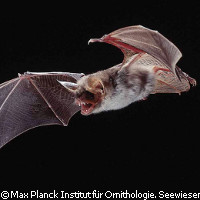Post-sunset glow helps night creatures navigate
Despite their nocturnal nature, bats use the direction of the Sun to calibrate the internal magnetic compass that they use to navigate, new EU-funded research shows. Details of the discovery, by scientists at Germany's Max Planck Institute for Ornithology and Bulgaria's National Museum of Natural History, are published online in the Proceedings of the National Academy of Sciences (PNAS). EU support for the work came from the ORIENTATION IN BATS ('Orientation in bats: from migration to spatial memory') project, a Marie Curie Outgoing International Fellowship (OIF) which received over EUR 250,000 under the Sixth Framework Programme (FP6). Bats famously use echolocation (biological sonar) to orient themselves over small areas, but how do they navigate over greater distances? After all, many bats fly up to 20 kilometres (km) from their roosts every night for their hunting jaunts, and summer and winter roosts are often over 50 km apart. A few species of bat even migrate up to 1,000 km across Europe every year. In recent years, research has revealed that, like many other creatures, some species of bat are able to navigate using the Earth's magnetic field. Navigating in this way is not without problems; iron deposits in the Earth's crust mean that the magnetic field varies unpredictably. Birds get round this problem by using the sun (a very reliable source of information on directions) to calibrate their internal compass. The aim of this study was to find out how greater mouse-eared bats (Myotis myotis) calibrate their compass. In the first experiment, the researchers wanted to determine whether the bats could find their way home from an unfamiliar location. The team captured wild bats and at sunset released them some 25 km from their roost cave. Small radio transmitters attached to the bats allowed the scientists to follow their progress. The bats revealed themselves to be excellent navigators, with most picking up the path home relatively quickly. The fastest bats made it back to the cave in just two hours. Meanwhile, a second group of bats had its magnetic sense scrambled, as the researchers used a device called a Helmholtz coil to alter the direction of the magnetic field during sunset, effectively shifting it 90° so that north moves to east. The bats' home roost lay south of the test site, but the animals exposed to the rotated magnetic field set off towards the east. 'The results of the first experiment in which the magnetic field was rotated at sunset are consistent with the hypothesis that observing some aspect of sunset calibrates the magnetic field, which is then used to provide bats with directional information,' the researchers write. Next, the team repeated the experiment once night had fully fallen and all traces of the sunset had disappeared from the sky. This time, the compass of the bats exposed to the altered magnetic field appeared to be unaffected, and both groups of bats flew off in the same direction. 'The manipulation of the magnetic field was only effective in combination with sunset,' commented Richard Holland of the Department of Migration and Immuno-Ecology at the Max Planck Institute for Ornithology. 'Greater mouse-eared bats used the position of the Sun at sunset as the most reliable indication of direction, and calibrated the magnetic field with it to use it as a compass later that night.' That M. myotis uses the Sun to calibrate its compass is rather surprising, as it usually emerges from its roost well after the Sun has slipped below the horizon. Nevertheless, the post-sunset glow appears to be enough for it to do so.
Countries
Bulgaria, Germany



